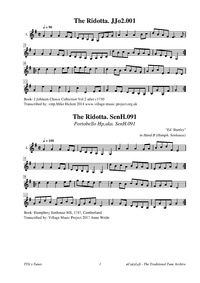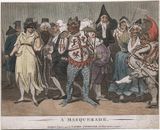Template:Pagina principale/Vetrina

Played by: English Folf Dance and Song Society
Source: Soundcloud
Image: A Masquerade Ball

The tune is a version of Portobello Hornpipe, the latter being a somewhat more developed variant. "Ridotta" seems to have been published mid-18th century and in circulation prior to the "Portobello" strain, but both coexisted for some time, although the "Ridotta" strain does not seem to have survived the 18th century.
The Ridotta was published in several major London collections of the mid-18th century: Walsh printed it in Caledonian Country Dances and Compleat Country Dances Master vol. 6 (1754), John Johnson issued it in Choice Collection of 200 Favourite Country Dances vol. 2 (1742 or after 1750), and John Simpson in Delightful Pocket Companion, vol. 2 (c. 1750).
A 'Ridotta' or 'Ridotto' referred to ridotto was a public ball, typically a masquerade, popular in the 18th century. The word had other meanings, however: it also was a concert hall in whose raised balcony the musicians performed, although the name also could refer to the foyer of a theater where people would go for refreshments during intermissions. Il Ridotto (It.: 'The private space') also referred to several illegal, privately owned gambling clubs that offered games of chance to members of Venice's nobility in the city's Rialto District, dating from 1638.
...more at: The Ridotta - full Score(s) and Annotations
X:1 T:Ridotta. JJo2.001, The Q:1/2=90 L:1/8 B:J.Johnson Choice Collection Vol 2 after c1750 Z:vmp.Mike Hicken 2014 www.village-music-project.org.uk M:C| K:G V:1 clef=treble name="1." [V:1] G2G2G2 FE|DCB,A, G,EFG|A2A2A2 Bc|dBAF E3F| G2G2G2 FE|DCB,A, G,A,B,C|dBcA BGAF|GEDB, G,4 :| |:d2d2d2 ef|gfgd e4|d2cB cBAG|ABcE F2 ED| G2e2 F2d2|E2c2D2 EF|G2 FE DCB,A,|B,GA,F|G4 :|
